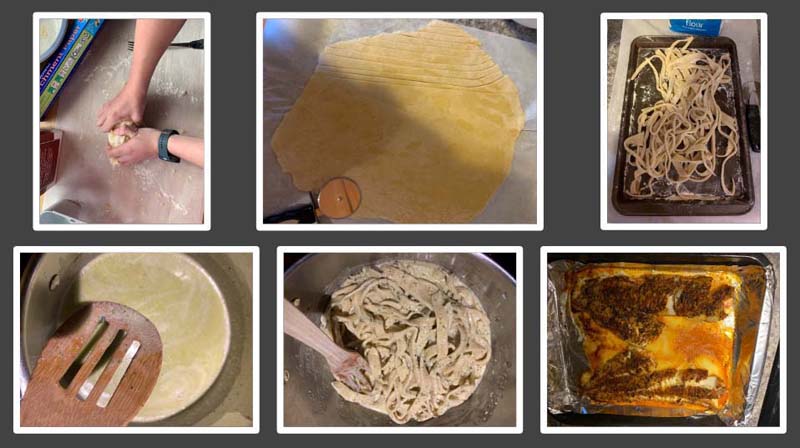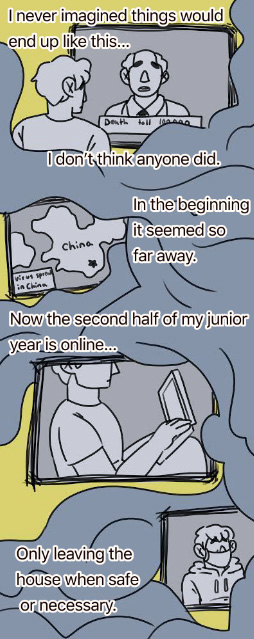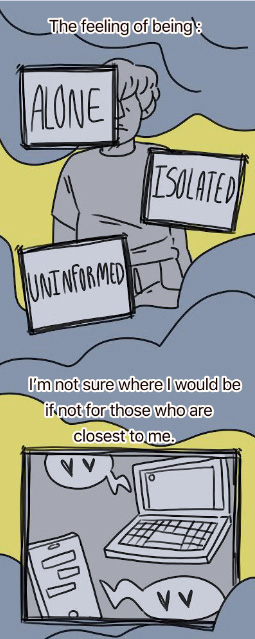
Wiscasset Middle High School student Lily Yeaton used some of her newfound free time to learn how to make homemade pasta. (Image courtesy Lily Yeaton)
The typical end-of-school routine for a high school junior involves SATs, spring sports, prom, and final exams.
This year, in the midst of COVID-19, regular activities have been canceled or postponed, and instead of making summer plans and touring college campuses, the students in Wiscasset Middle High School’s American history class have been documenting the highs and lows of being juniors during a pandemic.

A panel from Ty Delong’s graphic journal for his “Witness to History” project. Wiscasse Middle High School teacher Mary Ellen Bell assigned the project to students in her American history class. (Image courtesy Ty Delong)
The class’s teacher, Mary Ellen Bell, assigned the “Witness to History” project at the end of March, encouraging students to use journal entries, photography, and art to describe their experiences, both personal and academic.
At 16 and 17 years old, these students have navigated an entirely new way of learning while isolated from friends, family, and teachers. While adjusting to distance learning and a heavier-than-usual homework load, one student watched from afar as his grandmother died in March, unable to grieve with his family in person. Another student wrote about her worries that her dad, who was diagnosed with leukemia last year, may contract the virus from an outbreak at his job.
“This difficult event will absolutely, 100%, be recorded in our history books, documentaries and media going forward, and your children and grandchildren and future generations will read about it,” Bell wrote in the assignment description. She encouraged students to document both difficult moments and hopeful ones – “anything that you think might help future generations understand what we are going through.”
Without scheduled classes and extracurriculars, students have had to create their own structure in their days with no indication of how long the changes would last.
“At first we were closed for one week, and then it got moved to the end of the month, and then from there they just canceled the rest of the year,” said Gwen Webber, 17, of Westport Island. She and her friends are still wondering if they will return to school in the fall, but she worries that reopening will bring a new wave of illness.
“I’ve seen on the news that some places are having a relapse of the pandemic, so now I’m wondering – are we going to go back to school? Is this going to happen to us?” Webber said. “I’m not going to be surprised if we do get hit again.”
Webber has been working five days a week at Red’s Eats in Wiscasset since the stand’s opening day May 30, and before that spent time gardening for her elderly neighbors.
In a normal spring, she would spend her free time at track practice, training to break the girls’ record in the 300-meter hurdles. She wrote in her journal entries that losing her spring sports season challenged her sense of purpose, and as school got more difficult than usual, her motivation waned.
Matt Eckert, 17, of Wiscasset, also documented his struggle to keep up with distance learning, but wrote that he was trying not to complain because his experience with the pandemic could have been worse. In an April 7 journal entry, he wrote about the fear and discomfort of his first trip to the grocery store after physical distancing was required.

An excerpt from Wiscasset Middle High School junior Ty Delong’s graphic journal for his “Witness to History” project. (Image courtesy Ty Delong)
“I again realize something new, over the intercom was a recorded voice that was repeating guidelines and procedures they were requesting everyone to follow. This seemed like something out of a movie and gave me chills instantly,” Eckert wrote. “We take for granted how smoothly our economy runs normally. This made me realize how many things can have such a heavy effect on it.”
The pandemic has made it hard for Eckert to find a summer job, so he has been working with his dad, Larry Eckert, at FIX Marine, Truck, and Auto in Wiscasset.
Distance learning and the resulting schedule changes were difficult for everyone to adjust to, but some students used their newfound free time to learn new skills.
Lily Yeaton, 16, of Wiscasset, taught herself how to make pasta by hand, and her grandfather taught her how to identify the different types of trees by her house. Ty Delong, 17, of West Bath, started a garden of propagated succulents in his bedroom after his sophomore class adviser taught him how.
Yeaton turned her journal entries into a slideshow presentation, trying to make the project feel like a normal homework assignment. Delong, president of the school’s art club, created a graphic journal to give his feelings a visual and a narrative.
Although each student had different high points and challenges, they all reached similar conclusions when they reflected back on their projects – even though they were physically distanced from others, their experiences were not isolated.
“We are all witnessing history. In our own ways, mind-spaces and places,” Delong wrote at the conclusion of his project. “But we are doing it all together, we are not alone.”



